This is a comprehensive guide on how to feed and maintain a sourdough starter as well as troubleshooting common issues.
You'll find practical advice and expert tips to help successfully nurture and sustain a healthy sourdough starter for delicious homemade sourdough bread.
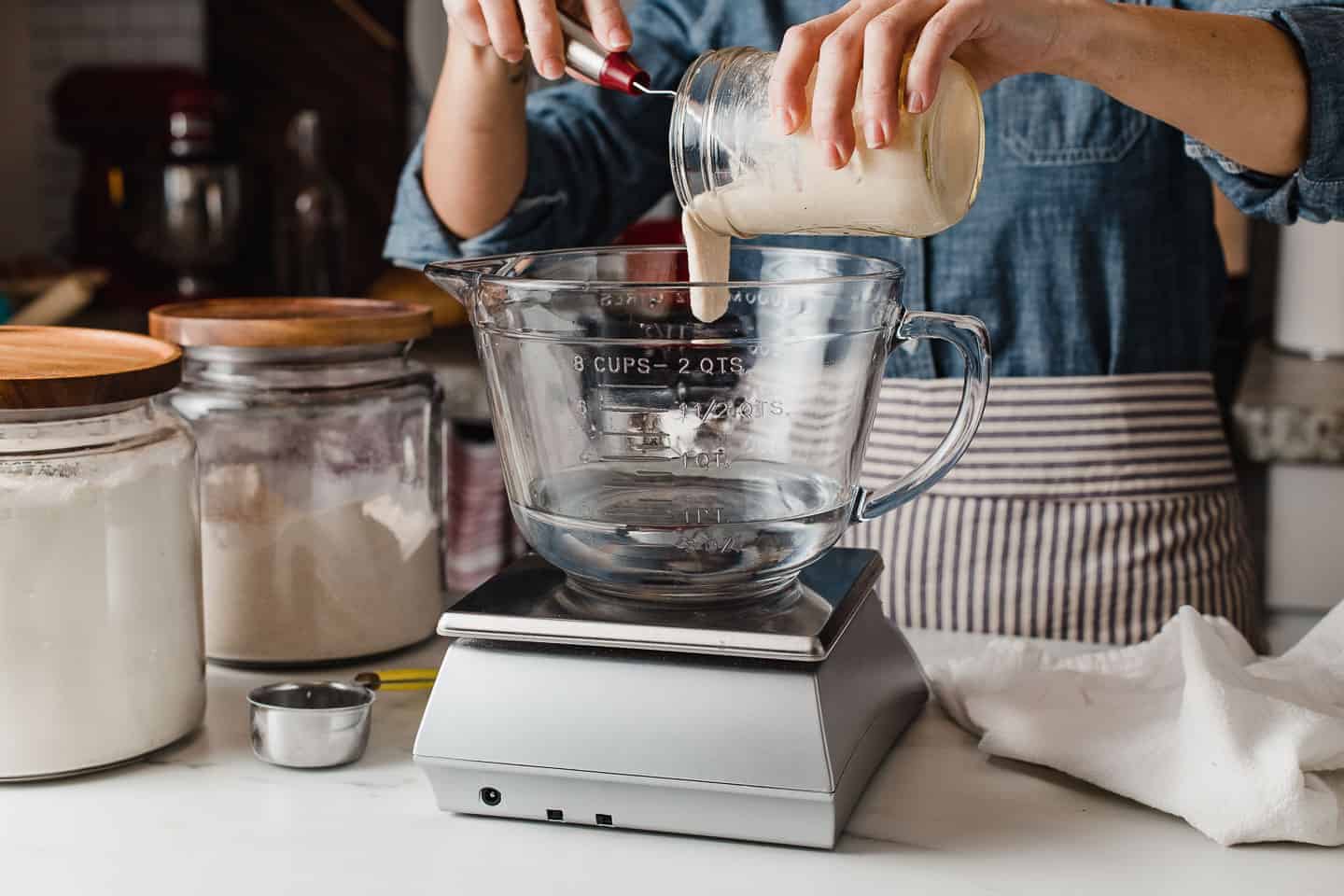
A sourdough starter plays a pivotal role in the sourdough bread baking process due to its unique properties and benefits.
Firstly, it serves as a natural leavening agent, replacing commercial yeast. The wild yeast and lactic acid bacteria present in the starter contribute to the fermentation process, resulting in a more flavorful and aromatic bread.
Secondly, sourdough starters enhance the texture and structure of baked goods, providing a desirable chewiness and improved shelf life.
Lastly, sourdough fermentation breaks down complex carbohydrates and gluten, making the bread easier to digest for those with gluten sensitivities. The complex flavors, improved texture, and digestive benefits make a sourdough starter a valuable asset in baking.
Jump to:
How often should I feed my sourdough starter?
The frequency of feeding your sourdough starter depends on various factors such as ambient temperature, desired fermentation speed, and your baking schedule.
In general, feeding your starter once a day or once a week is a common practice. However, the frequency can be adjusted based on the following guidelines:
- Daily Feeding: If you maintain your starter at room temperature (around 70-75°F or 21-24°C) and want it to be ready for baking within a day or two, daily feedings are recommended. Discard a portion of the starter and feed it with fresh flour and water every 24 hours.
- Twice-Daily Feeding: In warmer environments or if you prefer a faster fermentation process, you can feed your starter twice a day, approximately every 12 hours. This helps maintain a more active and vigorous starter.
- Refrigerator Storage: If you don't plan to bake frequently or want to slow down the fermentation process, you can store your starter in the refrigerator. When refrigerated, the feeding frequency can be reduced to once a week or even every two weeks. Remember to feed the starter and allow it to ferment at room temperature for a few hours before returning it to the refrigerator.
The key is to observe your starter's behavior and adjust the feeding frequency accordingly.
If it starts to develop a strong sour smell, becomes overly bubbly, or shows signs of slowing down (e.g., taking longer to rise after feeding), it may be an indication that your starter needs more frequent feedings.
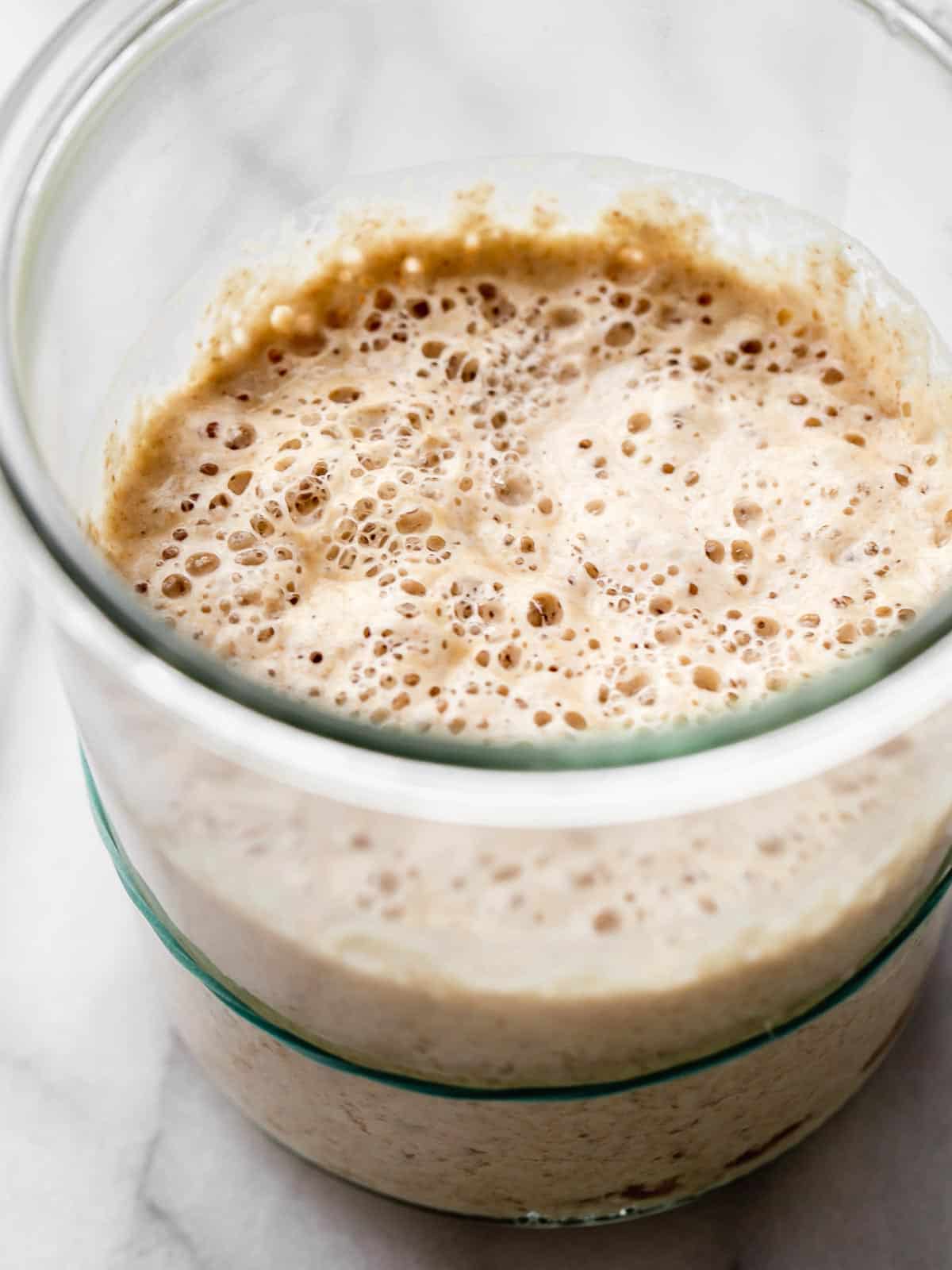
How much should I feed my sourdough starter?
Feeding ratios in sourdough starters refer to the proportion of flour and water used when refreshing or feeding the starter. The feeding ratio is typically represented as a ratio of flour and water to starter.
The ratios listed below result in a hydration level of 100%, meaning the weight of water equals the weight of flour.
Common feeding ratios for sourdough starters include:
1:1:1 Ratio: This ratio means using equal parts of flour, water, and starter by weight. For example, if you have 100 grams of a starter, you would feed it with 100 grams of flour and 100 grams of water.
This starter will rise quicker than a higher ratio of flour/water to the starter. Use this ratio if you want a starter that is ready in 4-6 hours.
1:4:4 Ratio: This ratio involves using four times the weight of flour and water compared to the starter. For instance, if you have 25 grams of starter, you would feed it with 100 grams of flour and 100 grams of water. Use this ratio if you want a sourdough starter that is ready to bake within 10-12 hours.
It's a good practice to experiment with different ratios and observe how they impact your sourdough baking results until you find a ratio that works well for your desired bread texture and flavor.
How to refresh your starter after it has been in the fridge for a while
A mature sourdough starter can last for several weeks kept in a refrigerator without being fed.
If your sourdough starter has been in the fridge for a while and you want to give it a refresh, follow the steps below.
- Discard all but 25 grams and add 100 grams of filtered water and 100 grams of flour.
- Mix vigorously with a spatula, cover lightly, and set on the counter for a few hours to allow the yeast to multiply.
- Place the jar back into the fridge until the next time it needs to be refreshed or you wish to bake sourdough.
Frequently asked questions
What is the best flour to feed my sourdough starter?
When feeding your sourdough starter, it is generally recommended to use high-quality, unbleached organic flour. The type of flour you choose can impact the flavor, activity, and overall health of your starter. Here are some common flour options for feeding your sourdough starter:
- All-Purpose Flour: All-purpose flour, which is a blend of hard and soft wheat, is a popular choice for feeding sourdough starter. It provides a good balance of protein and starch, which promotes a healthy fermentation process.
- Bread Flour: Bread flour has a higher protein content compared to all-purpose flour. This can contribute to increased gluten development and give your sourdough starter extra strength and structure.
- Whole Wheat Flour: Whole wheat flour adds nutritional value to your starter as it contains the bran and germ of the wheat kernel. It can provide a slightly nuttier flavor and enhance the complexity of your sourdough bread.
- Rye Flour: Rye flour can be used in combination with other flours or as a standalone option for feeding your sourdough starter. Rye flour contains enzymes that can help boost fermentation activity and contribute to a distinct flavor profile.
- Spelt Flour: Spelt flour is an ancient grain that can be used to feed your sourdough starter. It has a nutty flavor and can add a unique character to your bread.
It's worth noting that different types of flours may result in variations in flavor, fermentation speed, and texture.
You can experiment with different flour combinations and ratios to find the ones that produce the desired results for your baking preferences.
Additionally, using organic or locally sourced flours can add further depth to the flavor of your sourdough starter and bread.
What kind of water should I use in my sourdough starter?
When it comes to choosing water for feeding your sourdough starter, using water that is free from chlorine, chloramine, or other strong chemicals is generally recommended. Here are a few considerations:
- Filtered Water: Using filtered water, such as water from a home filtration system or a countertop filter, is a popular choice. It helps remove impurities and chemicals that could potentially hinder the activity of the natural yeasts and bacteria in your sourdough starter.
- Spring Water: Natural spring water can be an excellent option for feeding your sourdough starter. It is generally free from chlorine and other additives, and it often contains beneficial minerals that can contribute to the overall health and flavor of your starter.
- Tap Water: If your tap water is chlorinated, it's advisable to let it sit in an open container for at least 24 hours before using it to feed your starter. This allows chlorine to dissipate, as it can potentially have a negative impact on the fermentation process.
It's important to note that the quality and characteristics of water can vary depending on your location.
If you're unsure about the quality of your tap water, consider using filtered or spring water as a more reliable option.
Ultimately, the goal is to provide your sourdough starter with water that is free from chemicals that could inhibit its fermentation activity.
Can I use the discarded sourdough starter in recipes?
Yes, you can save and make use of sourdough discard in recipes. Sourdough discard refers to the portion of the starter that you remove and discard during the feeding process.
Instead of discarding it, you can repurpose the discard in various recipes to avoid waste and enjoy its unique flavor.
Collect the discarded sourdough starter in a separate container and store it in the fridge.
Here are a few ideas for using sourdough discard:
- Pancakes and Waffles: Incorporate the sourdough discard into pancake or waffle batters for added tanginess and flavor.
- Bread and Rolls: Add sourdough discard to zucchini bread or cinnamon rolls to enhance their flavor and texture. It can be used in combination with commercial yeast or in recipes specifically designed for sourdough discard.
- Crackers and Flatbreads: Use sourdough discard to make homemade crackers, tortillas, or naan. It adds a pleasant tang and complexity to these snacks.
- Quick Breads and Muffins: Incorporate sourdough discard into quick breads like banana bread or muffins. It adds moisture and a unique flavor profile to the baked goods.
- Pizza Dough: Make our easy sourdough pizza crust recipe for a unique flavor and improved texture.
How to make a backup of sourdough starter
Creating a backup of your sourdough starter is recommended in case of accidental loss or contamination. Here are a couple of ways you can make a backup.
How to dry sourdough starter
Spread 200 grams of active sourdough starter into a thin layer on a silicone mat or a piece of parchment paper. Allow it to air dry completely, for about 3-4 days depending on the temperature and humidity of your kitchen.

TIP: Store the sheet in a cold oven to keep it free from any debris that might be floating in the air. Place a sticky note on the oven so that you don't forget it's in there!
Once it's dry, break the starter into pieces and place them in a glass jar with a tight-fitting lid. Store in a cool dry place for 6-12 months.
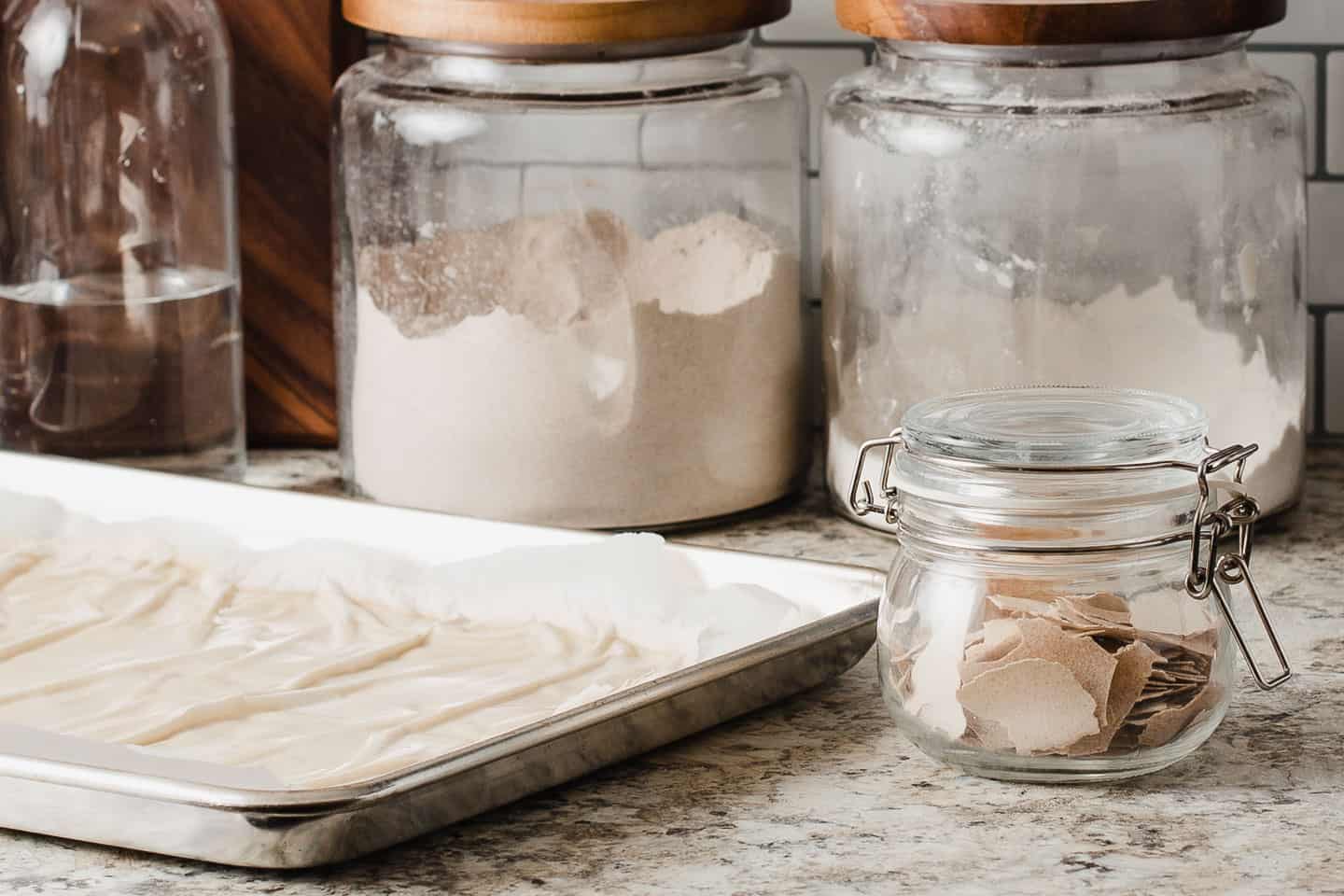
How to revive dried sourdough starter
To revive the dried sourdough starter, add 50 grams to a clean jar with 100 grams of water and 100 grams of flour. Let sit for 24 hours at room temperature.
The next day transfer 25 grams to a new jar and feed with 100 grams of water and 100 grams of flour. Feed the starter once a day until it starts to double in size.
How to freeze the sourdough starter
Pour the starter into an ice cube tray and place in the freezer until frozen. Transfer the cubes into a freezer-safe container and keep them frozen for up to 1 year.
How to revive frozen sourdough starter
To reactivate the frozen starter, place a cube into a jar and allow it to thaw. Once fully thawed, feed with 100g water and 100g flour.
The next day transfer 25 grams to a new jar and feed with 100 grams of water and 100 grams of flour. Feed the starter once a day until it starts to double in size.
Troubleshooting guide
Troubleshooting problems with a sourdough starter can help identify and address issues that may affect its health and performance. Here are some common problems you may encounter with your sourdough starter and suggestions on how to troubleshoot them:
Slow Fermentation or Lack of Activity
- Check the temperature: Ensure that your sourdough starter is kept in an environment with a consistent temperature between 70-75°F (21-24°C) for optimal fermentation.
- Adjust feeding schedule: Consider increasing the frequency of feedings to provide more food for the microorganisms, or try using a higher hydration ratio to boost activity.
Foul or Off Odor
- Evaluate your feeding routine: Check if you're feeding your sourdough starter often enough. A strong, unpleasant smell can indicate that the starter needs more frequent feedings.
- Discard and rebuild: If the off odor persists, you may consider starting over as it may be contaminated.
Hooch (Liquid) Separation
- Adjust feeding frequency: Hooch (a brownish liquid) that forms on top of your starter between feedings, indicates that the starter is hungry.
- Stir or pour off excess hooch: If hooch forms, stir it back into the starter or pour it off before feeding.
- Reduce hydration: If your starter consistently produces excessive hooch, try lowering the hydration level by using a lower water-to-flour ratio during feedings.
Mold Growth
- Maintain cleanliness: Ensure that all equipment used for your starter is clean and free from any contaminants.
- Avoid cross-contamination: Store your starter away from other ferments or food sources that could introduce unwanted molds or bacteria.
- Discard and start fresh: If mold growth occurs, it's best to discard the affected starter and begin a new batch using a thoroughly cleaned container and fresh ingredients.
Remember, sourdough starters can be resilient and may require some experimentation and adjustments to find the best practices for your specific environment and routine.
Observing your starter's behavior, making small modifications, and maintaining a consistent feeding schedule will help troubleshoot and maintain a healthy and active sourdough starter.
More sourdough baking resources
- Beginner Sourdough Starter Recipe
- Signs that your sourdough starter is ready to bake with
- Baking conversion chart
- Essential tools for sourdough bread baking
- Sourdough glossary
- Baking conversion chart
Do you like this recipe? Make sure to subscribe to our newsletter and we'll send you fresh recipes, valuable troubleshooting advice, useful tips, and other information we believe will be helpful to you!
This post was first published in May 2020 and revised in May 2023 with updated information and photos.
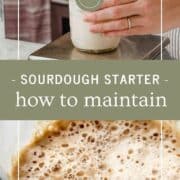
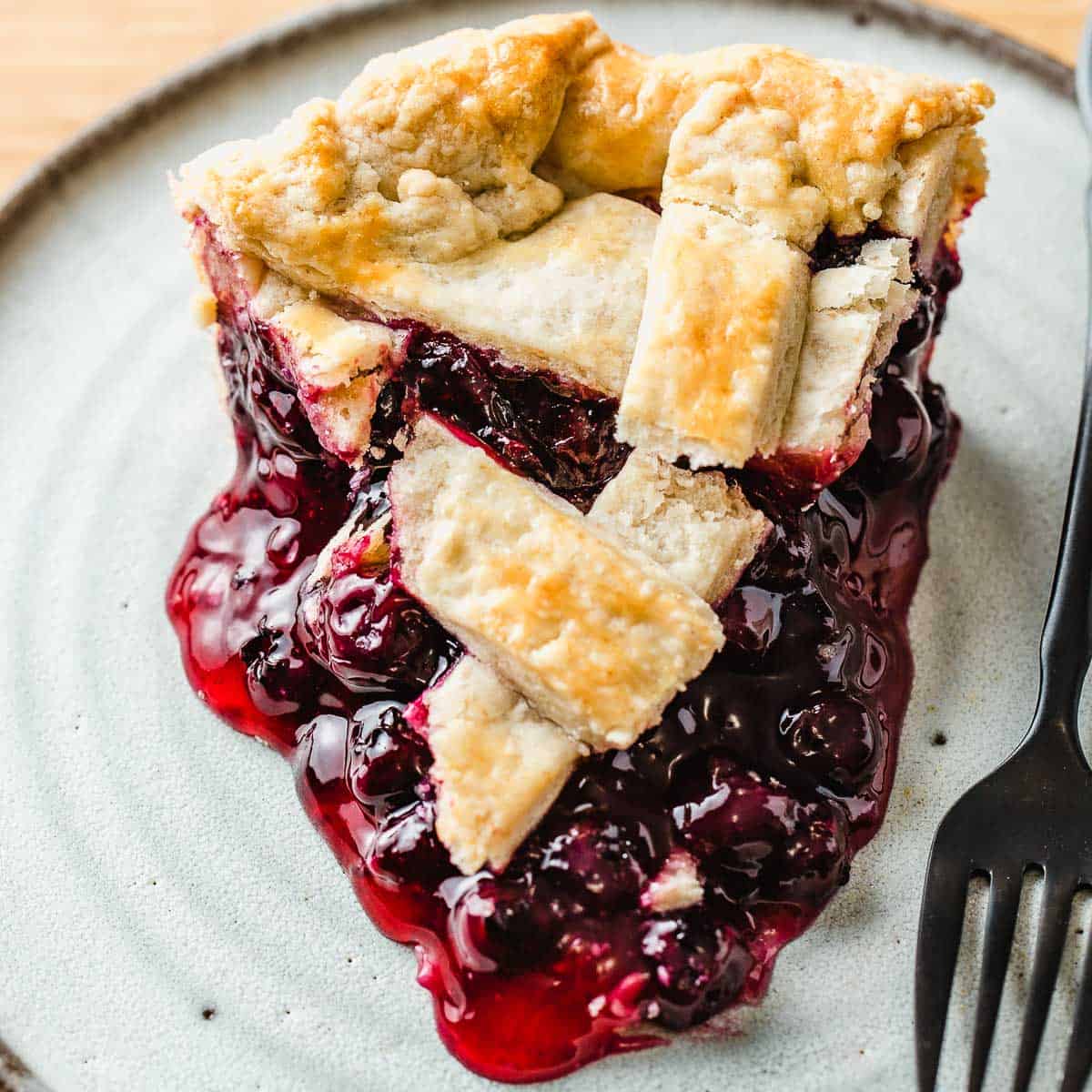

Katelin says
Hi! How do I share a starter? I was gifted a refrigerated starter and would like to share it with a friend!
Also, I’m still kind of lost with what to do with the starter I was given. Please help!
Amy Duska says
Hi Katelin! It's so easy to share a sourdough starter. Simply put some in a jar and feed it with equal parts of flour and water.:)
Alessia says
Hello, thanks for the advice and recipes. I am a bit confused about your starter maintenance routine- am I right in thinking you keep the 'mother' starter in the fridge, and only take a small amount out when you want to bake with it- So for the country loaf, you would take out 15 grams of the mother, then feed that 50g of flour and 50 of water, wait 12 hours then mix the dough. The mother starter in the fridge: does it get re- fed each time you take the 15 g out, so 7g of flour and 7 of water? (same amount you have taken out) or do you not feed the mother until it gets very low?
My starter is in the fridge, I make the levain the day before I bake, and feed the mother the same as I have taken out. Is it wrong? I don't discard any of the mother-but now I wonder if I am doing it wrong!
Amy Duska says
Hi Alessia, you are correct. I take from the Mother a small portion when I want to bake. When she starts to get low I feed her to build her back up again. They way you are maintaining is fine. There are so many ways to maintain a starter, what matters is what works for you and that you ensure you never run out 🙂
Alessia says
Thank you! Another question if I may: my levain almost never doubles in size...it only rises about 30%, but it is bubbly and floats after about 15 hours, so I use it regardless and the bread rises ok ( not as much as yours though) but I wonder if you have any tips...I follow your recipe 15g starter and 50/50 water and flour, normally half white wheat and half wholegrain. What can I do to make it rise more?
Amy Duska says
Hi Alessia, sometimes it just takes a little time for your starter to mature. You may want to experiment with using more starter in the recipe than what it calls for. If you are making the beginners sourdough bread, try using 100 grams of starter instead of 50 grams and see if that helps!
Brian says
Thank you for this. I was about to start searching for some information about starter for sourdough, and then your email alert came in -- perfect timing. This is very helpful; thanks again!
Amy says
Hi. I bake about once a week and store my starter in the refrigerator. If I want to take it out and use it to bake, am I supposed to stir down/ throw out the liquid and then use it or am I supposed to discard all but 25 grams, add 100grams of flour and 100 grams of water and then use that or let it sit on the counter for a couple of days, feed it and then bake ? Does my question make sense?
Thank you in advance
Amy Duska says
Hi Amy! Yes, discard and feed the starter and let it sit on the counter until doubled. You can use it to bake with when it's doubled in size. When I bake once a week, I take the starter out of the fridge, add 25g starter, 100g water and 100g flour to a jar, and let sit at room temperature overnight. The next morning the starter is ready for me to mix the dough with. Any remaining starter that is leftover gets transferred to my discard container in the fridge so that I can use it to make pancakes, pizzas and other sourdough discard recipes with!
Kathy Walgren says
Took my starter out yesterday and fed it. It doubled in size and was bubbly, but before I was to mix the dough, it had deflated back nearly to the starting level. Should I feed again and wait or just go ahead and use it?
Amy Duska says
It's better to use it before it starts to fall back down.
Megan Hensler says
Hi, I am new to sourdough and I am very confused on the storing process. My starter has been ready for a few days. I didn’t think about putting it in the fridge until I was ready to bake so I continued to feed it until I was ready for baking bread. I didn’t want to throw away the discard when I fed it each day since the yeast is active and doing well. But I didn’t want to store discard in the fridge. So today, after I fed the mother on the counter, I fed the discard portion to make it a mother and then store it in the fridge. But I did this 6x to 6 new jars because I didn’t know how to feed all of the discard to keep it a mother. So now I have 6 jars of mother’s in the fridge, but they are all stored separately. Can they all be stored together in one jar? I also didn’t know if I fed it correctly before placing in the fridge. There is so much discard left that I wanted to save it and feed it properly before storing it asleep in the fridge. I also did not let it sit for a few hours after feeding it and before storing in the fridge. Does that mean I ruined the mother in the fridge since it’s asleep?
Amy Duska says
Hi Megan! I know this whole process can be confusing at first. And believe me, when I first started years ago I had so many jars going too! 🙂 Just take all of the jars and combine the discard into one jar and place it in the fridge. When you are ready to bake, just take some from the jar and feed it in a separate jar. If you have any leftover after you bake, you can simply pour it into the discard jar. I hope this makes sense. Please check back in a week or two, I will be updating this post with clearer instructions! Please feel free to ask more questions 🙂
Lilly says
Hi I’m also really new at this just started today. I’m planning on when my starter is ready to bake only once a week. What do we do after using some of the starter for the bake. Do we feed it before we put it back in the fridge? And also another question when we feed the starter what’s the proportions of flour to water?
Amy Duska says
Hi Lily, after you use a portion of starter for your dough, you can simply place the jar back into the fridge without feeding. If your starter is gettin low in the jar you'll need to feed it to build it back up. Feed it equal weights of flour and water and place in the fridge. I usually use 100g water and 100g flour when I feed my starter.
Cecilia says
New to sourdough, I’m on day 7 of my starter. Yesterday I tried your discard pizza dough it was really delicious. It took a while about 20 plus hours for bulk fermentation, that was expected as my starter is not fully matured. It was exciting to see gas bubbles and air pockets in my dough. Thanks for your insight on starting and maintaining a sourdough starter. I plan on doing the discard method for a while I already have friends asking for a starter. Also plan to dry a starter. I really love that all the information is right at my fingertips. Looking forward to trying my first batch of sourdough bread and many other new recipes!! Thanks so much!!
Cindy Thomson says
I am re-dehydrating my stored sourdough starter. When you say give daily feedings until active and bubbly...how much am I feeding? I see a few small bubbles after 24 hours. How many days usually until it will be active again?
Amy Duska says
Hi Cindy, feed it daily like you normally would. I feed once a day with 25g starter 100g water and 100g flour. It will take about 3 days to get it going again!
Amy L says
I’ve been doing the no discard method for a while now, but i have been maintaining about a 1cup amount of the mother in the fridge, when I want to use it I take it out allow it to get to room temp then feed the whole thing the same amount of flour and about half the amount of water . Then from there I take what I need for my recipe. Then put it back in the fridge. It works well, it rises up and my bread turns out light and risen well, but is there anything wrong in doing it that way? After reading your tips I wonder why I have to transfer to a new jar?
Amy Duska says
Hi Amy! There is nothing wrong with your method at all! My guide is just for those starting out or anyone that needs help. The method I have for saving two containers is basically a little bit of a "guarantee" that you never use up all of the starter. When people are first starting out, this just helps them to always have some held back. 🙂
Stacy says
Hi! I am planning on trying your storing without a discard method. Question regarding feeding it the night before baking, 10g starter to 45g water and 45g flour does not quite follow the 1:4:4 method of feeding it. Is this still considered 100% hydration? Also, I would like to have 300 grams of active starter to bake with, so would I just triple all of those amounts - 30g starter, 135g water, and 135g flour? Thank you!
Amy Duska says
Hi Stacey, for the first question, yes it is considered 100% hydration because the ratio of flour and water being fed to the starter are equal weights. For your second question, yes, tripling those amounts will give you 300g of active starter. 🙂
Scott Stanley says
I LOVE your teaching style! Cooking/Baking became my CaronaHobby... I've had such a blast making things I never had taken the time to consider doing. I've read plenty and find your insight and how it's conveyed PERFECT!
Thanks a ton for the time invested! Can't wait to try all of these Sourdough recipes!
Best holiday wishes - Stay Safe & Healthy!
Amy Duska says
Thank you so much Scott!
Melanie says
When you ferment your sourdough for 7-12 hours (depending) at room temperature, do you just lightly cover the bowl or do you snap the lid on tightly?
Amy Duska says
I loosely cover my sourdough.